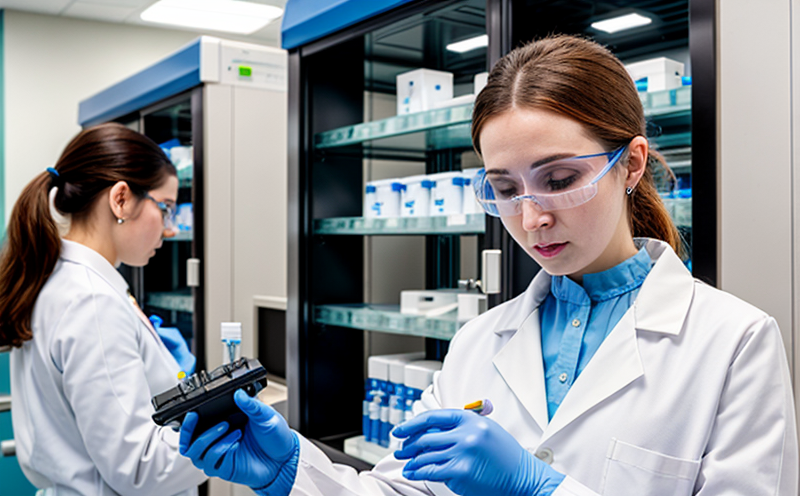UPLC MS MS Quantitation Testing
The UPLC (Ultra Performance Liquid Chromatography) coupled with tandem mass spectrometry (MS-MS) quantitation testing is a highly sensitive and precise analytical method used in the pharmaceutical sector. This technique finds extensive application in bioanalytical testing, where it ensures the accurate measurement of drug concentrations in biological matrices.
UPLC MS-MS quantitation testing involves the use of advanced instrumentation that allows for high-resolution separations and detection of analytes at very low concentrations. The process begins with sample preparation, which includes extracting the target compounds from biofluids such as plasma or serum. These samples are then injected into the UPLC system where they undergo separation based on their chemical properties.
The separated compounds subsequently enter the mass spectrometer, where each ion is identified by its mass-to-charge ratio (m/z). The tandem nature of MS-MS allows for a second round of analysis which provides additional selectivity and confidence in identifying the compound. This dual-stage process ensures that even closely related compounds can be distinguished.
The data collected from these analyses are then subjected to rigorous quality control checks, ensuring compliance with international standards such as ISO and ICH guidelines. Reporting is comprehensive, detailing not only quantification but also qualitative information about the sample components. The end result provides pharmaceutical companies with critical insights into drug performance and potential adverse effects.
The precision and accuracy of UPLC MS-MS quantitation testing make it indispensable for various phases of drug development from initial discovery to post-market surveillance. Its ability to handle complex mixtures, coupled with its high sensitivity, makes this method particularly useful in identifying trace amounts of active pharmaceutical ingredients (APIs) or metabolites.
Compliance officers and R&D engineers rely heavily on UPLC MS-MS quantitation testing to ensure that their products meet stringent regulatory requirements. For quality managers and procurement teams, the reliability and reproducibility offered by this method are crucial for maintaining product consistency and sourcing high-quality raw materials.
Industry Applications
The pharmaceutical industry heavily relies on UPLC MS-MS quantitation testing to ensure the safety and efficacy of their products. In drug development, it is used during preclinical studies and clinical trials to monitor pharmacokinetics – how a drug moves through the body after administration.
- Pharmacokinetic profiling helps determine the optimal dosage regimen by assessing absorption, distribution, metabolism, excretion, and toxicity.
- In bioequivalence studies, it is used to compare the concentration-time profiles of test formulations with those of reference products.
- For therapeutic drug monitoring (TDM), UPLC MS-MS quantitation testing allows clinicians to adjust dosages based on individual patient responses.
- During post-marketing surveillance, this method aids in detecting rare adverse events or unexpected interactions between drugs.
Beyond clinical applications, it also plays a vital role in formulation development and stability studies. Formulators use UPLC MS-MS quantitation testing to optimize formulations for better solubility, bioavailability, and shelf life.
The method's versatility extends into the area of quality assurance where it helps maintain product integrity by detecting impurities or degradation products that could affect drug efficacy or safety.
Environmental and Sustainability Contributions
While primarily focused on pharmaceutical analysis, UPLC MS-MS quantitation testing also has significant implications for environmental sustainability. Its high sensitivity enables the detection of trace amounts of pharmaceutical residues in water bodies, which can help identify sources of pollution.
Bioanalytical testing using this method supports regulatory compliance with standards like OECD guidelines aimed at minimizing environmental impacts from pharmaceuticals used in agriculture or veterinary medicine.
By ensuring that drugs are administered correctly and monitored effectively throughout their lifecycle, UPLC MS-MS quantitation testing contributes to reducing the overall burden of uncontrolled waste. This not only enhances public health but also supports sustainable practices within the pharmaceutical industry itself.
Frequently Asked Questions
Use Cases and Application Examples
The applications of UPLC MS-MS quantitation testing are broad and varied. In drug metabolism studies, this method helps researchers understand the metabolic pathways involved in drug elimination from the body. For instance, it can identify specific enzymes responsible for metabolizing a particular drug.
- In clinical trials, it has been used to assess the bioavailability of novel formulations by comparing their plasma concentration-time curves with those of an established reference product.
- During formulation development, it assists in determining optimal excipient combinations that enhance solubility and stability without compromising efficacy.
An example from real-world practice involves a case study where UPLC MS-MS quantitation testing was instrumental in identifying a previously unknown metabolite of a new antihypertensive drug. This discovery led to modifications in the formulation to prevent potential adverse effects caused by this metabolite.





